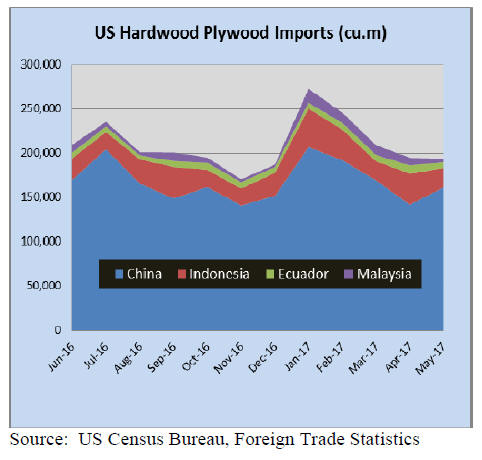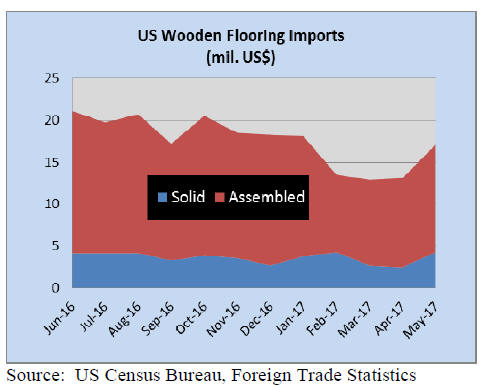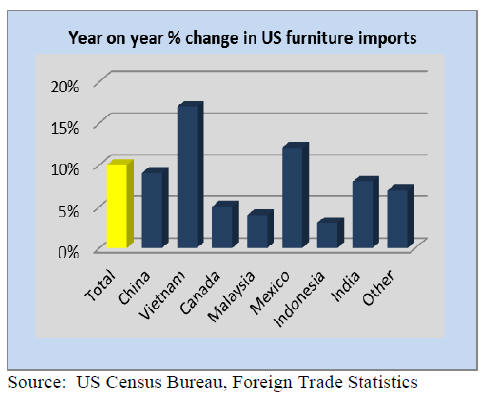|
Report from
North America
Continued growth in hardwood plywood imports from
China
Hardwood plywood imports were almost unchanged from
March and April, at 287,156 cu.m. However, year-to-date
import volumes were up 22% from May 2016. The value
of hardwood plywood imports grew 4% from the previous
month to US$164 million in May.
Plywood imports from China increased 14% in May to
161,273 cu.m., while imports from most other countries,
except Canada and Russia, declined in May. Imports from
Indonesia fell 39% to 21,642 cu.m. (-7%). Vietnamese
plywood shipments to the US grew to 5,579 cu.m. in May.
Despite the month-over-month decrease in May imports
from Indonesia, Malaysia and Ecuador, year-to-date
imports from all three countries grew compared to the
same time last year. Year-to-date imports from Malaysia
doubled compared to May 2016.

More hardwood mouldings from Brazil
Hardwood moulding imports grew 14% in May to
US$17.6 million. Year-to-date imports were slightly
higher (1%) than in May 2016.
The largest jump was in imports from Brazil, which
increased 27% to US$3.6 million. Imports from China
grew to US$6.6 million in May, up 27% year-to-date from
May last year.
Indonesian moulding shipments to the US market grew
78% month-over-month to just under US$1 million in
May. Moulding imports from Malaysia were up in May,
but year-to-date imports decreased by nearly one third
from May 2016.
Hardwood flooring imports surge
Imports of both hardwood flooring and assembled flooring
panels (engineered flooring) grew in May. Hardwood
flooring imports increased 72% from April to US$4.3
million and year-to-date imports were also up from May
2016. The strongest growth was in imports from Canada
and China, while imports from most tropical suppliers
grew at more moderate rates.
Brazil was an exception with US$407,757 worth of
hardwood flooring exports to the US in May, almost as
much as in the previous four months combined. Hardwood
flooring imports from Indonesia were worth US$630,984
in May, up 7% from April.

Assembled flooring panel imports were worth US$12.5
million in May, up 20% from April. Imports from Canada
and China decreased in May, while Indonesia significantly
increased its share in US imports. Imports of assembled
floor panels from Indonesia were worth US$1.6 million in
May, up 170% from the previous month. Year-to-date
imports from Indonesia were 71% higher than in May
2016.
Thailand and Indonesia shipped more assembled flooring
panels year-to-date than in May 2016. In hardwood
flooring China saw the largest gain, both month-overmonth
and year-to-date. In May imports from China were
worth US$904,146, followed by Indonesia (US$751,153)
and Malaysia (US$692,110).
Significant increase in wooden furniture imports
Wooden furniture imports grew 11% in May to US$1.63
billion. Year-to-date imports were up 10% from May
2016.
The strongest growth in imports was again from Vietnam
and China. Furniture imports from Vietnam grew 22% to
US$336.4 million. Imports from China were worth
US$662.1, up 16% from April.
Malaysia¡¯s exported US$51.2 million worth of wooden
furniture to the US in May, a 12% increase from the
previous month. Imports from Indonesia grew at the same
rate to US$51.7 million. Mexico and India also exported
more to the US in May.
Imports of all types of wooden furniture grew in May,
except office furniture. Imports of bedroom furniture
increased 17%, followed by seats (+13%) and wooden
furniture for other uses (+13%).

US furniture manufacturing up
The most recent estimate by the Bureau of Economic
Analysis revised GDP growth in the first quarter of 2017
up from previously 1.2% to 1.4%. In the fourth quarter,
real GDP increased 2.1%. The unemployment rate
remained almost unchanged at 4.4% in June. The rate has
declined 0.4 percentage points since January.
Economic activity in the manufacturing sector expanded in
June, according to the latest survey by the Institute for
Supply Management. Furniture manufacturing reported
the highest growth in June of all manufacturing industries.
Raw material prices increased in June for the furniture
industry. The wood products industry also grew and
reported strong growth in new orders.
Confidence in the economic outlook continued to decline
in early July, according to the University of Michigan¡¯s
survey of consumers. Hope for strong economic growth
after President Trump was elected appears to have largely
vanished. However, consumers¡¯ confidence in current
economic conditions was high. Based on the survey data
personal consumption will grow 2.4% in 2017.
IMF lowers growth forecast for US economy
The International Monetary Fund (IMF) has lowered its
economic growth forecasts for the US to 2.1% for 2017
and 2018, down from 2.3% and 2.5%, respectively. The
IMF cited as reasons uncertainty over the government¡¯s
fiscal policies and lower than expected growth in the first
quarter of this year.
The IMF headquarters themselves may move from
Washington DC to Beijing in about ten years, according to
IMF chief Christine Lagarde. The IMF¡¯s head office is
traditionally located in the country with the largest
economy which could be China in ten years.
Rising home prices and countervailing duties hit
housing market
Housing starts increased 8% in June to a seasonally
adjusted annual rate of 1,215,000, according to the US
Department of Housing and Urban Development and the
Commerce Department. Starts were 2% above the June
2016 rate. Single-family construction grew 13.5% in June.
The number of building permits issues, which indicates
future building activity, increased 7% in June from the
previous month at a seasonally adjusted annual rate. Multifamily
permits grew at a higher rate than single-family
authorizations.
Builders¡¯ confidence in the market for new single-family
homes slipped in July. It is at the lowest level since
November 2016, according to the National Association of
Home Builders/Wells Fargo Housing Market Index. High
sawn softwood prices are a particular concern to builders,
after the US imposed preliminary countervailing duties on
most Canadian softwood in April.
Sales of existing homes sales declined in June but
remained slightly higher than in June 2016, according to
the National Association of Realtors. Demand for homes
remains strong, but rising home prices and low inventory
dampened the sales pace.
The average sales price of new homes sold in the U.S. rose
by almost 12% during the year to February 2017, to
US$390,400, according to the U.S. Census
Bureau. Overseas buyers and recent immigrants purchased
almost 50% more residential property in the 2016-
17financial year compared to the same period earlier
according to the National Association of Realtors.
See: http://www.globalpropertyguide.com/news-
Foreign_investment_in_U_S_residential_real_estate_soars_despi
te_tight_inventory-3220
New Egger particleboard plant in North Carolina
Austrian based Egger Group plans to build its first
particleboard plant in the US in Lexington, North
Carolina. The company will invest approximately US$700
million to build the facility. North Carolina is the centre of
furniture manufacturing in the US, and the state has
offered economic development incentives of up to US$7.8
million to Egger if investment and job creation goals are
met.
See: https://www.egger.com/shop/en_JP/newspress/
news/item/23521_ex-en
|